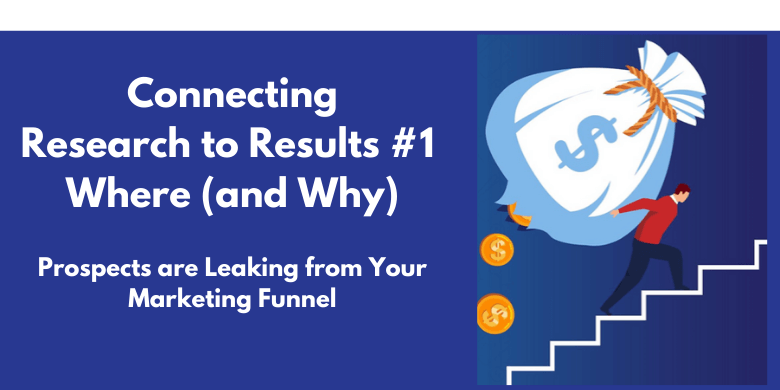Connecting Research to Results #1 – Where (and Why) Prospects are Leaking from Your Marketing Funnel

In a recent discussion with insights professionals at a conference, the discussion came up about how to use research and insights efforts to impact business results. For a third of the group, the conversation resembled “do what?”. For another third, the response was “that would be great, but I don’t even know where to start.” For the remaining professionals, the conversation focused on “we have a ton of data, but we don’t really have a systematic way to link it to business outcomes. Love to explore how to do this.”
No matter whether your response is one of these three answers or something different, companies expect a return on investment from the $46 Billion spent with market research companies last year alone. Yet virtually every research professional interviewed noted that there was virtually no quantitative measurement of the impact research had on business results. This is Part 1 of a 4 Part series on this topic to fully explore the richness of this critical topic.
Our research efforts with global brands covers four key aspects of the “Path to Purchase”:
- Marketing / Prospect Leakage – Turning unaware prospects into buyers and minimizing the “leakage” of prospects from the “Awareness-to-purchase” stage
- Sales / Revenue Leakage – Ensuring that customers can spend the full amount of their purchase intention during the sales & renewal journey, and that “Revenue leakage” throughout the customer lifecycle is minimized
- Customer Retention / Customer Leakage – Ensuring that customers receive the positive experience that will keep them coming back year after year and renewing their purchases with the company and brand. Especially important in B2B contractual customer relationships.
- Customer Satisfaction / Loyalty Leakage – Ensuring that customers receive the “on-brand” experience that results in high satisfaction/NPS scores that drives and sustains positive word-of-mouth” marketing.
Marketing / Prospect Leakage
Our customer journey research for the initial customer experience to answer these questions:
- If a company puts 100 prospects into the front end of their marketing funnel, is the “path to purchase” for the prospects clear – both from an internal perspective and a customer view?
- How many of the 100 ultimately end up buying?
- Where are prospects “lost along the way” (prospect leakage)? What “detours and potholes do they experience along the journey” that lead to their attrition?
- For prospects that successfully complete the path-to-purchase, what made their journey successful? How can that be replicated for the “lost prospects”?
- What can be done to improve the path-to-purchase in both speed and effectiveness?
A residential home construction company asked us these questions and challenged us to identify the “New Home Shopper Journey” as well as the “where and why” they lose prospects along the journey. They instinctively knew that if 100 Home buyers were looking at “New Construction Homes”, they were only getting a fraction of them actually buying “New Construction” (vs. existing resale homes) and that their construction company was only getting a fraction of those actually buying a newly constructed home. Though qualitative and quantitative research, we identified a well-defined journey that home shoppers followed from Discovery to Decision.
The insights that emerged included:
- There were over 20 clearly identified “friction points” along the journey that most shoppers experienced – and that business results were impacted by every friction point.
- Each friction point impacted shopper behavior in 1 of 4 ways:
- They would tolerate the friction and proceed forward
- They would engage a realtor to assist them with the shopping process
- They would still shop for a “newly built home” but switch their preference of builders
- They would drop their consideration of a “newly built home” and shop instead for an existing resale home
- The engagement of a realtor led to a huge drop in new construction homes visited – in over 1/3 of situation, realtors refused to show new construction homes to shoppers who specifically preferred “newly built homes”.
- Shoppers were interested in a number of digital shopping experience features – including virtual tours, interactive video tours of homes, room configurators and pricing tools.
Linking these insights to business results allowed us to model and quantify the following:
- 50% of Home shoppers specifically preferring a “newly built home” ended up buying an “existing resale home” instead
- 8 key friction points lead to the majority of the “50% leakage” of prospects along the journey
- 6 different shopper journey improvements would allow builders to improve the shopper journey and experience and would address not only the 8 key friction points, but many others as well
- Over 60% of shopper leakage could be prevented with the implementation of the 6 journey improvements
- These improvements translated to faster and more profitable sales of existing homes being built – with a profit improvement of more than 30% per new home
Call 1-800-549-7170 or send an email to nitin@goldresearchinc.com for a free consultation on this topic.
Gold Research is an award-winning Customer Journey Management firm with extensive experiences in B2C and B2B journey mapping, path-to-purchase research with a special focus in deploying “real-time” and behavioral/neuroscience research formats to gather in-the-moment customer insights.

Awarded by Feedspot
![]()
Contact Us
1-800-549-7170
GoldResearch, Inc.
8000 I.H. 10 West | Suite 600San Antonio, Texas, 78230